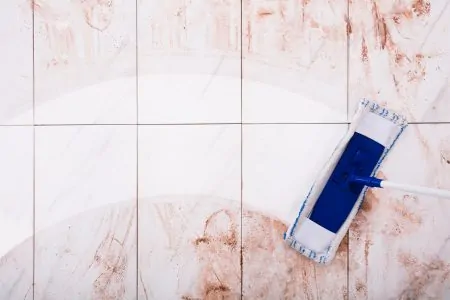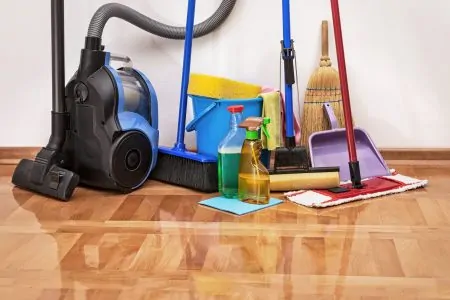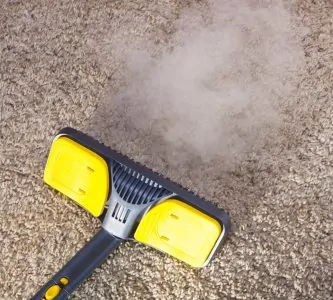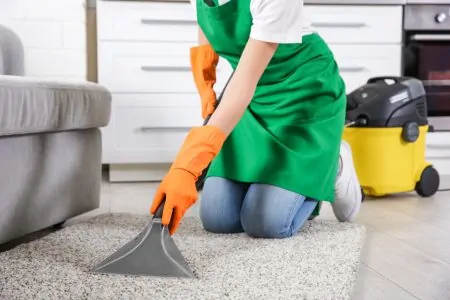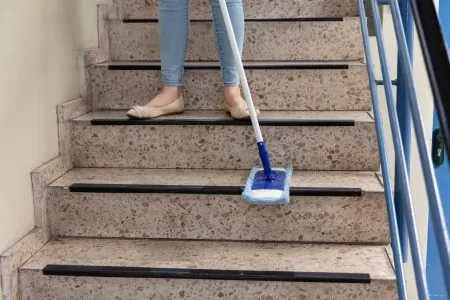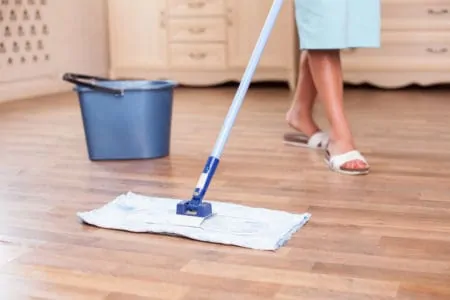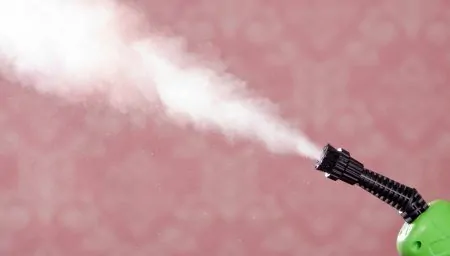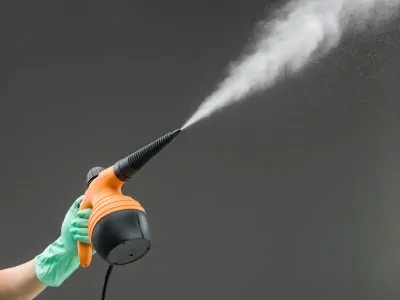Are you wondering whether it’s worth investing in a steam mop? Should you stick with a traditional mop instead and forego the hassle and cost?
This is a popular debate since there are so many mops to choose from nowadays. Both will clean the floors – but the question is, which one is best for your home?
Steam mops can sanitize your flooring, while traditional mops may be better for spills and quick accidents. Which product is going to come out on top? Let’s investigate and find out.
Key Takeaways
- Steam mops sanitize floors and are safe for kids and pets, while traditional mops capture dust and debris.
- Traditional mops are more affordable and suitable for all flooring types, but may require more physical effort.
- Steam mops can clean stubborn dirt and mold effectively but might be heavier and more expensive than traditional mops.
- Consider your cleaning needs, budget, and flooring types when choosing between a steam mop and a traditional mop.
Steam Mop vs. Traditional Mop
We’ve spent hours researching the advantages and disadvantages of these two cleaning devices. This includes analyzing customer feedback on different products and relating back to our own experiences. Let’s go over the pros and cons of each:
Steam Mop Pros
The steam mop is easy to use — just glide it around the floor for spick and span results. Steam mops boil water up to around 245 degrees Fahrenheit before releasing water vapor via a mop head.
They’re traditionally used by cleaning companies, especially for deep sanitization, like in healthcare facilities and hospitals. Recently, however, they’ve become a popular choice for single-family homes.
We have been using a steam mop in our home for nearly six years, and we thoroughly enjoy the results.
Best for Tough Dirt and Mold
Steam mops excel when it comes to stubborn dirt. The water vapor loosens grime before the mop head absorbs it. It can also tackle mold, and since it has a fast drying time, it lowers the chance of further mold growth.
Some steam mops, such as the models from the Shark company, have different cleaning settings. This lets you customize the intensity for a quick or deep clean.
Safe for Kids and Pets
A busy family home calls for clean, safe flooring. The thing we love about a steam mop is that it only uses steam – no need for nasty, toxic chemicals. Your kids and pets will be able to walk on the floors afterward without risking their health.
Just be sure to keep kids and pets away from the area while you clean, as the steam is scalding.
Kills Harmful Germs
Did you know that Salmonella can lurk on your floors for up to four weeks (1)? Thankfully, steam has natural sanitizing powers; it’s good for allergies and keeping your family healthy.
Studies have found that steam possesses the ability to kill MRSA and VRE. Believe it or not, it takes just five seconds of contact (2). In the long run, that’s little effort to combat these potentially-harmful pathogens.
Less Scrubbing Effort
Forget manual scrubbing or hard labor – using a steam mop is quick and nearly effortless. It only requires a little prep work, too.
All you’ve got to do is fill up the water tank and connect it to the power outlet. Some steam mops are cordless, which means they need a full charge.
The steam does all the hard work, and you just have to glide around. You can even do it with one hand.
Steam Mop Cons
Requires Electricity or Batteries
Steam mops require electricity or batteries to emit consistent hot water vapor. If your mop requires a constant connection, you always need to be near a power outlet. This may not be ideal if you’re working in a large space or trying to scrub outdoors.
A steam mop is normally simple to maneuver around objects. Just be careful of the power cord getting stuck or tangled around furniture or other items.
On the other hand, if the mop requires a specific battery usage, that raises different issues. First, you’ll need to have those batteries on hand. You’ll also have to make sure you’ve fully charged the mop before cleaning.
More Costly Than Traditional Mops
You may have a limited budget when it comes to cleaning accessories. We hate to break it to you, but steam mops can be a little pricey compared to traditional mops.
It’s going to come down to what you want to spend. Expect prices from around 50 dollars for the simple models up to around 150 dollars or more for higher-end and multi-functional options.
On the Heavier Side
Most steam mops are not lightweight, especially compared to traditional mops. You’re looking at around six to 10 pounds before you even fill up the water tank. This is compared to traditional mops, which average at around 3 pounds.
If you have a large home, especially with more than one level, be prepared to put a little work into lugging it up and down stairs.
Traditional Mop Pros
The mop and bucket are a cleaning classic. It’s now a lot more versatile than it once was, with many different shapes and sizes.
With no power cord or electricity needed, this one takes it back to the basics. You’ve got no user manual to read either. Fill the bucket up with your preferred cleaning solution, and you’re good to go.
Captures Dust and Bacteria
We favor microfiber mops over those with wool or cotton mop heads. Microfiber can reduce bacteria by 99 percent and has a static electric charge to capture dust (3).
The fibers work to trap any dirt present on your floor. A traditional mop may also be better than a steam mop for debris and crumbs.
Safe for Most Flooring
With a traditional mop, you’ve got the choice of a quick dry-clean or a damp mop for a deep clean. This allows for versatile cleaning to suit your household schedule.
But it also allows you to use a traditional mop on any flooring except for a carpet. You can’t use a steam mop on unsealed hardwood floors – yet a traditional mop can. You can dry mop the surface without any problems, picking up dirt on your way.
A traditional mop is safe to use on laminate, tiles, vinyl, and pretty much any other surface when it’s dry.
Good for Quick Clean-Ups
A traditional mop with a microfiber pad will be pretty absorbent. It can hold up to seven times its weight in water (4). This makes them suitable for cleaning up accidents after young kids or if you spill a drink.
Affordable Price
If money influences your purchasing decision, you may want to consider a traditional mop. They’re often affordable – definitely more budget-friendly than steam mops. Depending on the brand, the price will range from 16 to 45 dollars.
Traditional Mop Cons
Requires Some Physical Energy
Compared to steam mops, traditional mops do take more work. If you want to remove grime and stubborn dirt, you’ve got to put your back into it.
But this scrubbing may cause back pain. Often, this is because people bend the wrong way while they’re cleaning instead of staying upright (5).
You’ve also got to wring your mop when it gets too wet. While it doesn’t sound like a big deal, it’s still something you don’t have to do with a steam mop.
May Use Toxic Chemicals
It’s no secret that most cleaning solutions and detergents can harm our health. This includes ingredients such as d-Limonene, pine oil parabens, and 2-butoxyethanol (6).
The danger with a traditional mop is having to use toxic cleaning solutions to kill germs. Chemicals may not be safe for households with furry friends and young children.
FAQs
In Conclusion
It’s ultimately going to be your decision whether you prefer a steam mop or a traditional mop.
If you’re looking for one that sanitizes your floors and is safe for kids and pets, consider the steam mop. It might be able to deal with stubborn dirt, mold, and stains too.
A traditional mop might be better for capturing dust and debris. Microfiber mop heads trap dirt and are suitable for all flooring. It’s also absorbent for spills. If budget is important to you, this will be the cheapest option.
